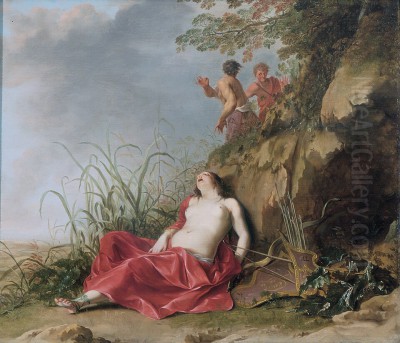
Dirck van der Lisse (1586-1669) stands as a notable, if sometimes overlooked, figure in the rich tapestry of Dutch Golden Age painting. Active primarily in Utrecht and The Hague, he carved a niche for himself with his enchanting landscapes, often imbued with mythological or pastoral narratives. A distinguished pupil of the celebrated Cornelis van Poelenburch, Van der Lisse absorbed the Italianate sensibility that characterized his master's work, translating it into scenes of serene beauty, delicate light, and refined execution. His career was not confined to the easel; he also played a significant role in the artistic and civic life of The Hague, eventually serving as its mayor. This exploration delves into the life, art, and enduring legacy of Dirck van der Lisse, a painter who skillfully blended the real and the imagined in his captivating canvases.
Early Life and Artistic Apprenticeship in Utrecht
Born in Utrecht in 1586, Dirck van der Lisse's early life details are somewhat sparse, a commonality for many artists of his era. However, it is firmly established that by the mid-1620s, he was under the tutelage of Cornelis van Poelenburch (c. 1594-1667). This apprenticeship was pivotal in shaping Van der Lisse's artistic trajectory. Poelenburch, a leading figure among the first generation of Dutch Italianate painters, had spent time in Italy, particularly Rome, and returned to Utrecht imbued with a style that favored idyllic, sun-drenched landscapes populated with small, often mythological or biblical, figures.
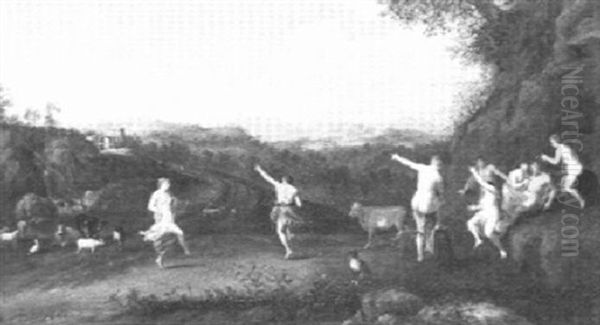
Poelenburch's influence on Van der Lisse was profound. He is widely considered one of Poelenburch's most talented and faithful students, mastering the smooth, enamel-like finish, the warm, golden light, and the preference for arcadian themes that were hallmarks of his teacher's style. Utrecht, at this time, was a vibrant artistic center. It was home to the Utrecht Caravaggisti, such as Hendrick ter Brugghen (1588-1629), Gerard van Honthorst (1592-1656), and Dirck van Baburen (c. 1595-1624), who had also absorbed Italian influences, albeit of a more dramatic, tenebrist nature. While Van der Lisse's work did not directly emulate the stark chiaroscuro of the Caravaggisti, the broader artistic environment of Utrecht, with its strong connections to Italian art, undoubtedly contributed to his development.
The Italianate Style and Thematic Preferences
Dirck van der Lisse's oeuvre is dominated by landscapes that evoke the pastoral tranquility of the Roman Campagna, even if he himself may not have traveled to Italy. This was a common practice among Italianate painters; some, like his master Poelenburch or Bartholomeus Breenbergh (1598-1657), had firsthand experience of Italy, while others absorbed the style through their teachers and the circulation of prints and drawings. Van der Lisse excelled in depicting these idealized southern landscapes, characterized by rolling hills, ancient ruins, and a soft, atmospheric light that bathes the scene in a gentle glow.
His thematic choices often revolved around mythological narratives, biblical stories set in pastoral contexts, and purely arcadian scenes featuring shepherds and nymphs. Works such as his series "The Felicity of the Shepherds" exemplify this preference. These paintings transport the viewer to a timeless, idyllic world where figures, often nude or classically draped, engage in leisurely pursuits, dance, or repose amidst nature. The inclusion of nude figures, while rooted in classical and Renaissance traditions, was a somewhat bold choice for the Dutch market of the time, showcasing his confidence and artistic conviction. His handling of the human form was delicate and graceful, harmonizing with the serene landscapes they inhabited.
Signature Works and Artistic Collaborations
Several key works highlight Dirck van der Lisse's artistic prowess. "Pastoral Landscape with Dancing Shepherds" is a quintessential example, showcasing his ability to create a joyous, harmonious scene. The figures are elegantly rendered, their movements fluid, and the landscape itself is imbued with a warm, inviting light. Another significant piece, "Arcadian Landscape," further demonstrates his mastery of the Italianate style, with its carefully composed scenery, rich yet subtle color palette, and an overall sense of peace and timelessness. These works often feature his distinctive monogram "DVL," which helps in their attribution.
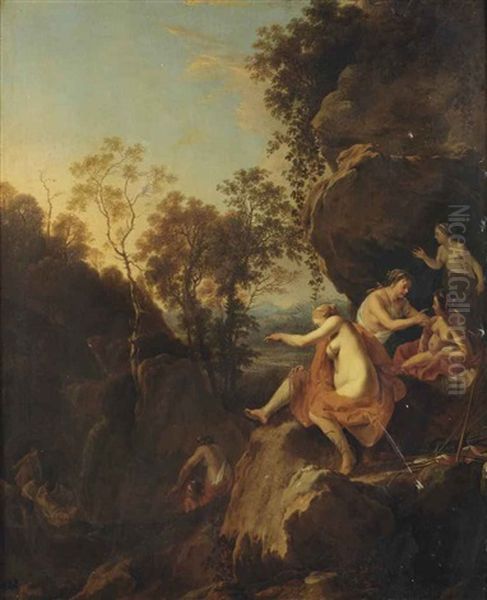
Van der Lisse was also involved in collaborative projects. He contributed to a series titled "The Felicity of the Shepherds" for the Aloysius von Almas Palace in Amsterdam, a commission that underscores his reputation and desirability as a painter of such themes. He also received commissions from prominent patrons, including Frederik Hendrik, Prince of Orange, and his wife Amalia van Solms-Braunfels, for whom he created pastoral scenes. Such patronage from the highest levels of Dutch society speaks volumes about the esteem inwhich his art was held. His ability to create refined, elegant works suitable for aristocratic interiors was clearly recognized. Other artists who enjoyed princely patronage for similar Italianate or classical themes included Gerard van Honthorst, who also worked extensively for Frederik Hendrik.
Career in The Hague and the Confrerie Pictura
Around 1644, Dirck van der Lisse made a significant move, settling in The Hague. This city was not only the political center of the Dutch Republic but also a burgeoning hub for the arts. Upon his arrival, or shortly thereafter, he became a founding member of the Confrerie Pictura. This was a new painters' guild established in The Hague in 1656, formed by artists who sought greater autonomy and prestige than that afforded by the traditional Guild of Saint Luke, which often grouped painters with house painters and other craftsmen.
The establishment of the Confrerie Pictura was a significant development in the professionalization of artists in The Hague. Its members included prominent painters, and Van der Lisse's role as a founding member indicates his standing within the artistic community. He was active alongside other notable Hague painters such as Adriaen Hanneman (c. 1603-1671), a distinguished portraitist, and later figures like Jan van Goyen (1596-1656), though Van Goyen was more associated with tonal landscapes. Other members of the Confrerie with whom Van der Lisse would have interacted included Daniël Vertangen (or Vertangen, often cited as Daniël Vert), François Verwilt, and Jan van Haensbergen, who also sometimes worked in a style reminiscent of Poelenburch. This association provided a platform for artistic exchange, mutual support, and the upholding of professional standards.
Contemporaries and the Broader Artistic Milieu
Dirck van der Lisse operated within a vibrant and diverse artistic landscape. While his style was firmly rooted in the Italianate tradition of Poelenburch, he was a contemporary of some of the greatest names in Dutch art who explored vastly different genres and styles. Rembrandt van Rijn (1606-1669), his exact contemporary in terms of lifespan, was revolutionizing history painting and portraiture in Amsterdam with his dramatic use of light and profound psychological insight. In Haarlem, Frans Hals (c. 1582/83-1666) was capturing the vitality of his sitters with unprecedented immediacy in his portraits.
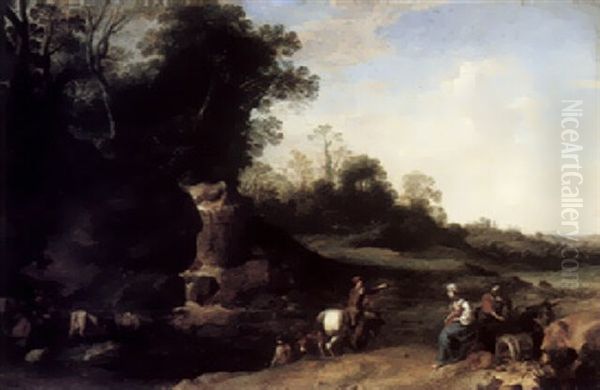
In the realm of landscape painting itself, while Van der Lisse focused on idealized Italianate scenes, other Dutch artists were pioneering a more naturalistic depiction of their native Dutch scenery. Jacob van Ruisdael (c. 1628-1682) and Meindert Hobbema (1638-1709) created powerful and evocative images of the Dutch countryside. Even within the Italianate school, there was diversity. Artists like Jan Both (c. 1610/18-1652) and Nicolaes Berchem (1620-1683) developed their own distinct variations, often on a larger scale and with a different atmospheric quality than the jewel-like paintings of Poelenburch and Van der Lisse. Jan Asselijn (c. 1610-1652) was another prominent Italianate painter known for his landscapes with animals and genre scenes. The presence of such diverse talents underscores the richness of the Dutch Golden Age, a period where artistic innovation flourished across multiple genres.
Civic Responsibilities and Later Life
Beyond his artistic endeavors, Dirck van der Lisse achieved considerable social standing. In 1660, he was appointed as one of the mayors (burgomasters) of The Hague, a position of significant civic responsibility and prestige. He continued to serve in this capacity until his death in 1669. This ascent to high public office is remarkable for an artist and indicates that he was a respected and capable figure in his community, likely possessing administrative skills and social connections that extended beyond the art world.
However, his personal life was marked by tragedy. Like many families in the 17th century, Van der Lisse experienced the profound sorrow of losing children at a young age and also mourned the death of his first wife. The high rates of infant and maternal mortality during this period cast a shadow over many lives, and artists were not immune to such personal hardships. Despite these personal sorrows, he maintained a productive artistic career and fulfilled his civic duties with dedication.
Misattributions and Art Historical Assessment
In the centuries following his death, Dirck van der Lisse's work, like that of many artists from his era, sometimes faced issues of attribution. His style, being closely aligned with that of his master Cornelis van Poelenburch, occasionally led to his paintings being mistakenly attributed to Poelenburch, or vice versa. For instance, some works now firmly given to Van der Lisse were once thought to be by his teacher. There are also documented instances of his works being misattributed to other artists entirely. One notable example is a painting depicting the Flight into Egypt, which was for a time believed to be by the renowned French classicist landscape painter Claude Lorrain (1600-1682), a testament to the quality and appealing nature of Van der Lisse's work.
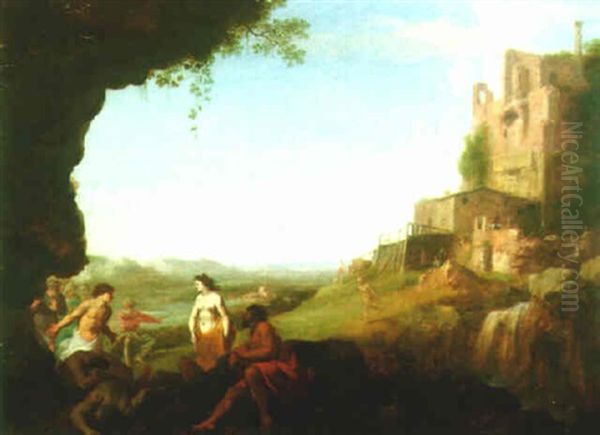
Modern art historical scholarship, through careful stylistic analysis, study of signatures (his "DVL" monogram being key), and archival research, has done much to clarify his oeuvre and re-establish his distinct artistic identity. Scholars like Marijke de Kinkelder have made significant contributions to the study of Dutch Italianate painters, including Van der Lisse, helping to differentiate his hand from Poelenburch's and to appreciate his specific contributions. While perhaps not possessing the groundbreaking originality of a Rembrandt or a Vermeer (1632-1675), Van der Lisse was a highly skilled and sensitive painter who excelled within his chosen genre.
His paintings are held in numerous public and private collections worldwide, including the Hermitage Museum in St. Petersburg and the Wadsworth Atheneum Museum of Art. Academic literature, such as articles discussing his "Diana and Callisto" or analyses of his career found in broader studies of Netherlandish art, continues to explore his technique, thematic choices, and place within the Poelenburch school.
Legacy and Conclusion
Dirck van der Lisse passed away in 1669 in The Hague, the city where he had achieved both artistic and civic prominence. He left behind a body of work that continues to charm viewers with its idyllic beauty, refined execution, and gentle lyricism. As a leading pupil of Cornelis van Poelenburch, he played an important role in popularizing the Italianate landscape tradition in the Netherlands. His paintings offered an escape to an arcadian world, a vision of pastoral serenity that appealed to the sophisticated tastes of his patrons.
His ability to combine meticulous technique with evocative mythological and pastoral themes secured him a respected place among his contemporaries. The fact that he rose to become mayor of The Hague further underscores his multifaceted talents and esteemed position in society. While the towering figures of the Dutch Golden Age often dominate historical narratives, artists like Dirck van der Lisse are crucial to understanding the breadth and depth of artistic production during this remarkable period. His legacy is that of a dedicated craftsman, a purveyor of beauty, and a significant contributor to the rich tradition of Dutch Italianate landscape painting, whose works continue to be appreciated for their elegance and tranquil charm. His art reminds us of the enduring human desire for idyllic worlds, masterfully rendered by a skilled hand from a golden era of painting.